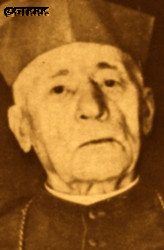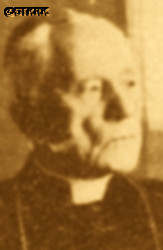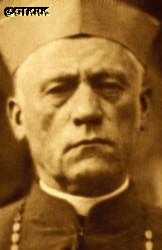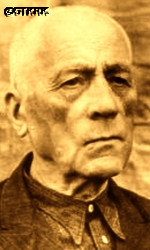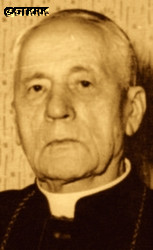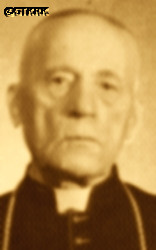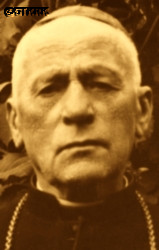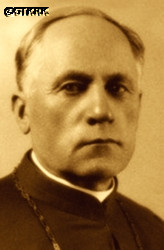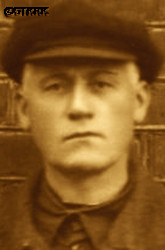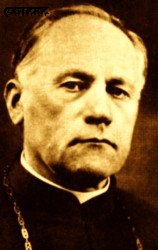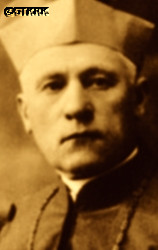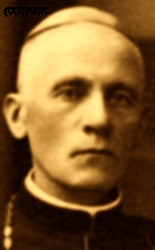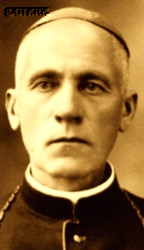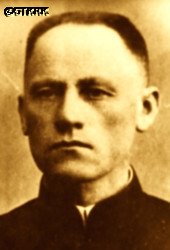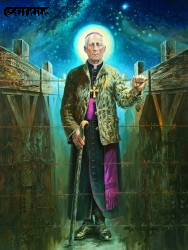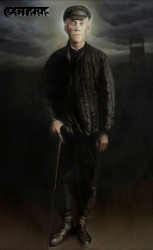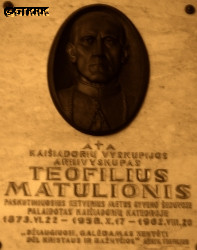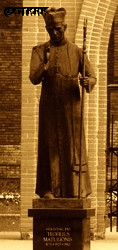Roman Catholic
St Sigismund parish
05-507 Słomczyn
85 Wiślana Str.
Konstancin deanery
Warsaw archdiocese, Poland
full list:
displayClick to display full list

searchClick to search full list by categories
wyświetlKliknij by wyświetlić pełną listę po polsku

szukajKliknij by przeszukać listę wg kategorii po polsku

Martyrology of the clergy — Poland
XX century (1914 – 1989)
personal data
religious status
blessed
surname
MATULIONIS
forename(s)
Theophilus (pl. Teofil)
forename(s)
versions/aliases
Teofilius
function
bishop
creed
Latin (Roman Catholic) Church RCmore on
en.wikipedia.org
[access: 2014.09.21]
diocese / province
Kaišiadory diocesemore on
en.wikipedia.org
[access: 2017.06.16]
Mogilev archdiocesemore on
en.wikipedia.org
[access: 2013.06.23]
honorary titles
Cross of Vytis (Lithuania) — Commander's Grand 2nd Classmore on
en.wikipedia.org
[access: 2025.02.11]
(07.06.2006)
Cross of Life–Saversmore on
lt.wikipedia.org
[access: 2025.08.19]
(2003)
nationality
Lithuanian
date and place
of death
20.08.1962

Šeduvatoday: Šeduva eld., Radviliškis dist., Šiauliai Cou., Lithuania
more on
en.wikipedia.org
[access: 2022.06.29]
details of death
In 1909/1910 penalised by Russian Tsarist authorities for christening a baby from a mixed Catholic and Orthodox family and sent to a Dominican monastery n. St Catherine church in Sankt Petersburg.
For the first time arrested by the Russians in 1923.
Tried on 21‐25.03.1923 in Moscow together with Abp John Cieplak and Fr Constantine Budkiewicz, among others.
Sentenced to 3 years in prison.
Held in a „correction house” in Sokolniki n. Moscow and next in Butyrki prison in Moscow.
Released in 1925.
Nominated Auxilliary Bishop of Mogilev archdiocese and clandestinely ordained on 09.02.1929.
Arrested again by the Russians on 24.11.1929.
After 11 months of interrogations and torture sentenced to 10 years of slave labour in Russian concentration camps Gulag.
Transported to ITL SLON Anzer Island (part of Solovetsky Islands camp).
There, after finding out his role as a chaplain to the group of priest held prisoners there, sentenced on 05.07.1932 in mass trial of priests‐prisoners of Solovetsky Islands to another year in prison.
Moved to Sankt Petersburg prison where held in isolation, and next to Lodeynoye Pole on Ladoga lake concentration camp, part of ITL SvirLag concentration camp.
Slaved at forest clearances.
In 1933 brought back to Moscow prison and in 10.1933 swapped in an exchange between Lithuanian and Russians spies.
Returned to Lithuania.
In 1934‐1936 travelled to United Stated visiting Lithuanian parishes there, to Rome, Egypt, Holy Land and Poland.
In 1936 returned to Lithuania.
After German and Russian invasion of Poland in 09.1939 and start of the II World, after start of Lithuanian occupation of part of Polish Vilnius county in 09.1939, after Russian annexation of Lithuania in 06.1940 and start of Russian occupation, and at last after German attack on 22.06.1941 of their erstwhile ally, Russians, and start of German occupation provided help to persecuted Jews — among others helped rescue efforts of Jewish children.
After end of hostilities of the World War II and start of Russian occupation of Lithuania in 1944/1945 arrested by the Russians on 18.12.1946 yet again.
For refusal to collaborate with Russians sentenced to 7 years in prison.
Transported to Russian prison in Vladimir on Klaźma and next in 1954 — marked as an invalid — to Russian concentration camp Potma in Mordovia republic (prob. ITL TemLag camp).
Released in 1956.
Returned to Lithuania but forbidden to stay in his Kaišiadorys dioscese.
Moved to Birštonas village.
On 17.10.1958 forced to move to Šeduva village n. Radviliškis — as a punishment for clandestinely ordaining Fr Vincentas Sladkevičius as a bishop.
In 08.1962 received an invitation for participation in the Second Vatican Council in Rome.
On 17.08.1962 murderous Russian KGB police raided his house during which they made him an unexpected injection of „sedative medical drug”.
3 days later perished.
Years later it was determined that was poisoned prob. by injection of heavy metals.
cause of death
murder
perpetrators
Russians
sites and events
ITL TemLagClick to display the description, Vladimir (on Klaźma river)Click to display the description, Ribbentrop‐MolotovClick to display the description, Pius XI's encyclicalsClick to display the description, ITL SvirLagClick to display the description, Trial of 05.07.1932Click to display the description, ITL SLONClick to display the description, OLP AnzerLagClick to display the description, GulagClick to display the description, Moscow (Butyrki)Click to display the description, Trial of 21‐25.03.1923Click to display the description
date and place
of birth
04.07.1873

Kudoriškistoday: Skiemonys eld., Anykščiai dist., Utena Cou., Lithuania
more on
lt.wikipedia.org
[access: 2020.07.31]
parents
MATULIONIS George
🞲 1833, Žibėčiaitoday: Suginčiai eld., Molėtai dist., Utena Cou., Lithuania
more on
lt.wikipedia.org
[access: 2025.01.21] — 🕆 1911, Dusetostoday: Dusetos eld., Zarasai dist., Utena Cou., Lithuania
more on
en.wikipedia.org
[access: 2025.01.21]

JUOČEPYTĖ Anne
🞲 1851, Bajoraitoday: Alanta eld., Molėtai dist., Utena Cou., Lithuania
more on
lt.wikipedia.org
[access: 2025.01.21] — 🕆 09.05.1877, ?
presbyter (holy orders)
ordination
17.03.1900

Sankt Petersburgtoday: Saint Petersburg city, Russia
more on
en.wikipedia.org
[access: 2020.07.31]
positions held
1962
titular archbishop ad–personam — Kaišiadorys RC diocese — appointment: on 09.02.1962
1943 – 1962
bishop — Kaišiadorys RC diocese — appointment: on 09.01.1943
till 1940
Chaplain in Chief — Lithuanian Armed Forces
1936 – 1940
rector — Kaunastoday: Kaunas city dist., Kaunas Cou., Lithuania
more on
en.wikipedia.org
[access: 2022.06.29] ⋄ St Nicholas the Bishop and Confessor RC church
1936 – 1940
chaplain — Kaunastoday: Kaunas city dist., Kaunas Cou., Lithuania
more on
en.wikipedia.org
[access: 2022.06.29] ⋄ monastery, Benedictine Nuns OSB
1928 – 1943
titular bishop — Matrega RC diocese — appointment: on 08.12.1928; ordination: on 09.02.1929, in secret, in Mary's Holiest Heart church in Sankt Petersburg
1928 – 1943
auxiliary bishop (Lat. episcopus auxiliaris) — Mogilev RC archdiocese — appointment: on 08.12.1928
1925 – 1929
parish priest — Sankt Petersburgtoday: Saint Petersburg city, Russia
more on
en.wikipedia.org
[access: 2020.07.31] ⋄ Sacred Heart of Jesus RC parish ⋄ Sankt Petersburgtoday: Saint Petersburg city, Russia
more on
en.wikipedia.org
[access: 2020.07.31] RC deanery
1918 – 1923
parish priest — Sankt Petersburgtoday: Saint Petersburg city, Russia
more on
en.wikipedia.org
[access: 2020.07.31] ⋄ Sacred Heart of Jesus RC parish ⋄ Sankt Petersburgtoday: Saint Petersburg city, Russia
more on
en.wikipedia.org
[access: 2020.07.31] RC deanery
1910 – 1918
vicar — Sankt Petersburgtoday: Saint Petersburg city, Russia
more on
en.wikipedia.org
[access: 2020.07.31] ⋄ St Catherine of Alexandria the Virgin and Martyr RC parish ⋄ Sankt Petersburgtoday: Saint Petersburg city, Russia
more on
en.wikipedia.org
[access: 2020.07.31] RC deanery
1901 – c. 1909
parish priest — Bikavatoday: Gaigalava pog., Rēzekne mun., Latvia
more on
lv.wikipedia.org
[access: 2022.06.29] ⋄ Sacred Heart of Jesus RC parish ⋄ Rēzekne / on Lubāns lakedeanery name
today: Latvia RC deanery
1900 – 1901
vicar — Varakļānitoday: Varakļāni pog., Varakļāni mun., Latvia
more on
en.wikipedia.org
[access: 2022.06.29] ⋄ Assumption of the Blessed Virgin Mary and St Michael the Archangel RC parish ⋄ Rēzekne / on Lubāns lakedeanery name
today: Latvia RC deanery
1892 – 1900
student — Sankt Petersburgtoday: Saint Petersburg city, Russia
more on
en.wikipedia.org
[access: 2020.07.31] ⋄ philosophy and theology, Metropolitan Theological Seminary — with a break in 1893‐1895
others related
in death
REINYSClick to display biography Mieczyslav, SZEPTYCKIClick to display biography Casimir Mary (Fr Clement), JANULAITISClick to display biography Francis, LAUKAITISClick to display biography Joseph, MIRONASClick to display biography Vladislav
sites and events
descriptions
ITL TemLag: Russian Rus. Исправи́тельно‐Трудово́й Ла́герь (Eng. Corrective Labor Camp) ITL Rus. Темниковский (Eng. Temnykovskiy) — concentration and slave forced labor camp (within the Gulag complex) — headquartered initially in Temnykov and then in Yavas in Republic of Mordovia. Founded on 06.06.1931. Prisoners slaved at the forest felling and logging, production of consumer goods (including the production of clothing, e.g. uniforms for the Russian army, footwear), hemp and jute cultivation, production of armament materials (ammunition containers), construction of railway lines, e.g. Ryazan‐Potma, etc. At its peak c. 31,000 prisoners were held there: e.g. 22,166 (1932); 30,978 (1933); 28,329 (1934); 30,912 (01.01.1935); 20,974 (01.01.1936); 25,544 (01.01.1937); 22,821 (01.01.1939); 17,865 (01.01.1941); 15,803 (01.01.1947); 19,419 (01.01.1948). In 1943, out of 14,896 prisoners, there were 6,204 women. Ceased operations on 12.10.1948 and most of the prisoners were reclassified to the ITL DubrawLag concentration camp. (more on: old.memo.ruClick to attempt to display webpage
[access: 2024.04.08])
Vladimir (on Klaźma river): On of the harshest Russian prisons for political prisoners where dozens of catholic priest were held.
Ribbentrop‐Molotov: Genocidal Russian‐German alliance pact between Russian leader Joseph Stalin and German leader Adolf Hitler signed on 23.08.1939 in Moscow by respective foreign ministers, Mr. Vyacheslav Molotov for Russia and Joachim von Ribbentrop for Germany. The pact sanctioned and was the direct cause of joint Russian and German invasion of Poland and the outbreak of the World War II in 09.1939. In a political sense, the pact was an attempt to restore the status quo ante before 1914, with one exception, namely the „commercial” exchange of the so‐called „Kingdom of Poland”, which in 1914 was part of the Russian Empire, fore Eastern Galicia (today's western Ukraine), in 1914 belonging to the Austro‐Hungarian Empire. Galicia, including Lviv, was to be taken over by the Russians, the „Kingdom of Poland” — under the name of the General Governorate — Germany. The resultant „war was one of the greatest calamities and dramas of humanity in history, for two atheistic and anti‐Christian ideologies — national and international socialism — rejected God and His fifth Decalogue commandment: Thou shall not kill!” (Abp Stanislav Gądecki, 01.09.2019). The decisions taken — backed up by the betrayal of the formal allies of Poland, France and Germany, which on 12.09.1939, at a joint conference in Abbeville, decided not to provide aid to attacked Poland and not to take military action against Germany (a clear breach of treaty obligations with Poland) — were on 28.09.1939 slightly altered and made more precise when a treaty on „German‐Russian boundaries and friendship” was agreed by the same murderous signatories. One of its findings was establishment of spheres of influence in Central and Eastern Europe and in consequence IV partition of Poland. In one of its secret annexes agreed, that: „the Signatories will not tolerate on its respective territories any Polish propaganda that affects the territory of the other Side. On their respective territories they will suppress all such propaganda and inform each other of the measures taken to accomplish it”. The agreements resulted in a series of meeting between two genocidal organization representing both sides — German Gestapo and Russian NKVD when coordination of efforts to exterminate Polish intelligentsia and Polish leading classes (in Germany called «Intelligenzaktion», in Russia took the form of Katyń massacres) where discussed. Resulted in deaths of hundreds of thousands of Polish intelligentsia, including thousands of priests presented here, and tens of millions of ordinary people,. The results of this Russian‐German pact lasted till 1989 and are still in evidence even today. (more on: en.wikipedia.orgClick to attempt to display webpage
[access: 2015.09.30])
Pius XI's encyclicals: Facing the creation of two totalitarian systems in Europe, which seemed to compete with each other, though there were more similarities than contradictions between them, Pope Pius XI issued in 03.1937 (within 5 days) two encyclicals. In the „Mit brennender Sorge” (Eng. „With Burning Concern”) published on 14.03.1938, condemned the national socialism prevailing in Germany. The Pope wrote: „Whoever, following the old Germanic‐pre‐Christian beliefs, puts various impersonal fate in the place of a personal God, denies the wisdom of God and Providence […], whoever exalts earthly values: race or nation, or state, or state system, representatives of state power or other fundamental values of human society, […] and makes them the highest standard of all values, including religious ones, and idolizes them, this one […] is far from true faith in God and from a worldview corresponding to such faith”. On 19.03.1937, published „Divini Redemptoris” (Eng. „Divine Redeemer”), in which criticized Russian communism, dialectical materialism and the class struggle theory. The Pope wrote: „Communism deprives man of freedom, and therefore the spiritual basis of all life norms. It deprives the human person of all his dignity and any moral support with which he could resist the onslaught of blind passions […] This is the new gospel that Bolshevik and godless communism preaches as a message of salvation and redemption of humanity”… Pius XI demanded that the established human law be subjected to the natural law of God , recommended the implementation of the ideal of a Christian state and society, and called on Catholics to resist. Two years later, National Socialist Germany and Communist Russia came together and started World War II. (more on: www.vatican.vaClick to attempt to display webpage
[access: 2023.05.28], www.vatican.vaClick to attempt to display webpage
[access: 2023.05.28])
ITL SvirLag: Russian Rus. Исправи́тельно‐Трудово́й Ла́герь (Eng. Corrective Labor Camp) ITL Rus. Свирьский (Eng. Svirskiy) — concentration and slave forced labor camp (within the Gulag complex) — headquartered in Lodeynoye Polye in Sankt Petersburg Oblast. Founded on 17.09.1931, on the basis of subcamps No. 9 and 10 of the ITL SLON concentration camp on the Solovetsky Islands, encompassing former Alexander Svirsky monastery among others. Prisoners slaved at the forest clearing and obtaining firewood destined for Sankt Petersburg, c. 240 km away, in sawmills, wood processing plants, in civil and railway construction, in mica and stone mines, in clay mining, in agricultural work and in the production of consumer goods, etc. At its peak c. 48,000 prisoners were held there: e.g. 47,400 (12.1932); 43,770 (01.01.1934); 40,761 (01.01.1935); 44,273 (01.06.1935); 34,856 (01.01.1936); 22,774 (01.01.1937). Among them were many political and religious prisoners. Many were shot within the camp during the so‐called The Great Purge of 1937‐1938. Formally ceased operations in c. 07.1937. (more on: old.memo.ruClick to attempt to display webpage
[access: 2024.04.08])
Trial of 05.07.1932: Russian trial of Catholic priests held in Solovetsky Islands and Anzer Island, accused of „creation of an anti‐Russian group that conducted anti‐Russian agitation, clandestinely celebrated Mass and religious rites and maintained an illegal contact with a free worker for purposes of transmitting abroad information of an espionage character about the situation of Catholics in the Russia”. The prisoners were given prolonged sentences in concentration camp and spread them among the various Gułag camps.
ITL SLON: Russian Rus. Исправи́тельно‐Трудово́й Ла́герь (Eng. Corrective Labor Camp) ITL Rus. Солове́цкий ла́герь осо́бого назначе́ния Ла́герь (Eng. Solovetsky Special Purpose Camp) SLON — concentration and slave forced labor camp (within what was to become Gulag complex) — headquartered in Solovetsky Islands in Arkhangelsk Oblast. Founded on 13.10.1923 in a famous Orthodox monastery. In the 1920s, one of the first and largest concentration camps in Russia. The place of slave labor of prisoners — at forest felling, sawmills, peat extraction, fishing, loading work on the Murmansk Railway Main Line, in road construction, production of food and consumer goods, at the beginning of the construction of the White Sea ‐ Baltic canal, etc. The concept of the later system of Russian Gulag concentration camps prob. had its origins in the Solovetsky Islands camp — from there the idea spread to the camps in the area covered by the construction of the White Sea ‐ Baltic canal, i.e. ITL BelBaltLag, and from there further, to the entire territory of the Russian state. From the network of camps on the Solovetsky Islands — also called the Solovetsky Islands archipelago — prob. also comes the concept of the „Gulag Archipelago” created by Alexander Solzhenitsyn. It is estimated that tens to hundreds of thousands of prisoners passed through the Solovetsky Islands concentration camps. At its peak, c. 72,000 prisoners were held there: e.g. 14,810 (12.1927); 12,909 (03.1928); 65,000 (1929); 53,123 (01.01.1930); 63,000 (01.06.1930); 71,800 (01.01.1931); 15,130 (1932); 19,287 (1933) — c. 43,000 of whom were murdered, including the years 1937‐1938 when c. 9,500 prisoners were transported from the camp and murdered in several places of mass executions, including Sandarmokh, Krasny Bor and Lodeynoye Polye. Among them were many Catholic and Orthodox priests. After the National Socialist Party came to power in Germany in 1933, a German delegation visited the ITL SLON camp, to „inspect” Russian solutions and adopt them later in German concentration camps. It operated until 04.12.1933, with a break from 16.11.1931 to 01.01.1932, when it was part of and later became a subcamp of the ITL BelBaltLag camp. It operated as such until 1939 (from 1936 as a prison). (more on: old.memo.ruClick to attempt to display webpage
[access: 2024.04.08])
OLP AnzerLag: Russian Rus. Отдельный лагерный пункт (Eng. Separate Camp Unit) OLP on the Anzer Island on White Sea. On the Island, 47 km2, belonging to Solovetsky Islands archipelago, Russians organised one of the first concentration camps in Russia (part of ITL SLON Solovetsky Islands concentratoin camp). In 1930s c. 32 Catholic priests were held there most of who perished. (more on: en.wikipedia.orgClick to attempt to display webpage
[access: 2014.12.20])
Gulag: The acronym Gulag comes from the Rus. Главное управление исправительно‐трудовых лагерей и колоний (Eng. Main Board of Correctional Labor Camps). The network of Russian concentration camps for slave labor was formally established by the decision of the highest Russian authorities on 27.06.1929. Control was taken over by the OGPU, the predecessor of the genocidal NKVD (from 1934) and the MGB (from 1946). Individual gulags (camps) were often established in remote, sparsely populated areas, where industrial or transport facilities important for the Russian state were built. They were modeled on the first „great construction of communism”, the White Sea‐Baltic Canal (1931‐1932), and Naftali Frenkel, of Jewish origin, is considered the creator of the system of using forced slave labor within the Gulag. He went down in history as the author of the principle „We have to squeeze everything out of the prisoner in the first three months — then nothing is there for us”. He was to be the creator, according to Alexander Solzhenitsyn, of the so‐called „Boiler system”, i.e. the dependence of food rations on working out a certain percentage of the norm. The term ZEK — prisoner — i.e. Rus. заключенный‐каналоармец (Eng. canal soldier) — was coined in the ITL BelBaltLag managed by him, and was adopted to mean a prisoner in Russian slave labor camps. Up to 12 mln prisoners were held in Gulag camps at one time, i.e. c. 5% of Russia's population. In his book „The Gulag Archipelago”, Solzhenitsyn estimated that c. 60 mln people were killed in the Gulag until 1956. Formally dissolved on 20.01.1960. (more on: en.wikipedia.orgClick to attempt to display webpage
[access: 2024.04.08])
Moscow (Butyrki): Harsh transit and interrogation prison in Moscow — for political prisoners — where Russians held and murdered thousands of Poles. Founded prob. in XVII century. In XIX century many Polish insurgents (Polish uprisings of 1831 and 1863) were held there. During Communist regime a place of internment for political prisoners prior to a transfer to Russian slave labour complex Gulag. During the Great Purge c. 20,000 inmates were held there at any time (c. 170 in every cell). Thousands were murdered. (more on: en.wikipedia.orgClick to attempt to display webpage
[access: 2020.05.01])
Trial of 21‐25.03.1923: Show trial against abp John Cieplakow, 14 Catholic priest and one lay Catholic held on 21‐25.03.1923 in Moscow accused of „participation in a counter‐revolutionary organization aiming at counter‐acting the decree on the separation of the church from the state”, of „incitement to rebellion by superstition”. The Russian prosecutor thundered: „Any movement directed against the Soviet government is counter‐revolutionary and must be punished as such. For belonging to an organization whose essence I have explained, all defendants deserve the highest penalty”. And lo‐and‐behold abp Cieplak and Fr Budkiewicz were sentence to death, the others got from 6 months to 10 years of prison or slave labour. Fr Budkiewicz was murdered in prison. Abp Cieplak’s sentence was subsequently reduced to 10 months of slave labour and he was exchanged for Russian spies in Poland among whom was Bolesław Bierut, future first Russian governor in Commie‐Nazi Poland, conquered in 1945 by Russia. Most of the other accused were exchanged for Russian spies as well and went to Poland. At least five however did not return from prisons, concentration camps and exile, among them Fr Leonidas Fiodorov, first Greek‐Catholic exarch in Russia, who in 2001 was beatified by pope St John Paul II. (more on: en.wikipedia.orgClick to attempt to display webpage
[access: 2014.11.22])
sources
personal:
pl.wikipedia.orgClick to attempt to display webpage
[access: 2021.12.19], www.teofilius.ltClick to attempt to display webpage
[access: 2018.09.02]
original images:
kauno.diena.ltClick to attempt to display webpage
[access: 2018.09.02], zw.ltClick to attempt to display webpage
[access: 2018.09.02], www.teofilius.ltClick to attempt to display webpage
[access: 2018.09.02], 8diena.ltClick to attempt to display webpage
[access: 2018.09.02], www.15min.ltClick to attempt to display webpage
[access: 2018.09.02], www.kaisiadoriumuziejus.ltClick to attempt to display webpage
[access: 2018.09.02], en.delfi.ltClick to attempt to display webpage
[access: 2018.09.02], en.delfi.ltClick to attempt to display webpage
[access: 2018.09.02], zukasalanta.ltClick to attempt to display webpage
[access: 2018.09.02], www.lituanus.orgClick to attempt to display webpage
[access: 2018.09.02], www.findagrave.comClick to attempt to display webpage
[access: 2018.09.02], commons.wikimedia.orgClick to attempt to display webpage
[access: 2018.09.02], www.findagrave.comClick to attempt to display webpage
[access: 2018.09.02], www.bernardinai.ltClick to attempt to display webpage
[access: 2018.09.02], www.teofilius.ltClick to attempt to display webpage
[access: 2018.09.02], www.facebook.comClick to attempt to display webpage
[access: 2018.09.02], commons.wikimedia.orgClick to attempt to display webpage
[access: 2021.12.19], www.findagrave.comClick to attempt to display webpage
[access: 2018.09.02]
LETTER to CUSTODIAN/ADMINISTRATOR
If you have an Email client on your communicator/computer — such as Mozilla Thunderbird, Windows Mail or Microsoft Outlook, described at WikipediaPatrz:
en.wikipedia.org, among others — try the link below, please:
LETTER to CUSTODIAN/ADMINISTRATORClick and try to call your own Email client
If however you do not run such a client or the above link is not active please send an email to the Custodian/Administrator using your account — in your customary email/correspondence engine — at the following address:

giving the following as the subject:
MARTYROLOGY: MATULIONIS Theophilus
To return to the biography press below:
 Click to return to biography
Click to return to biography








